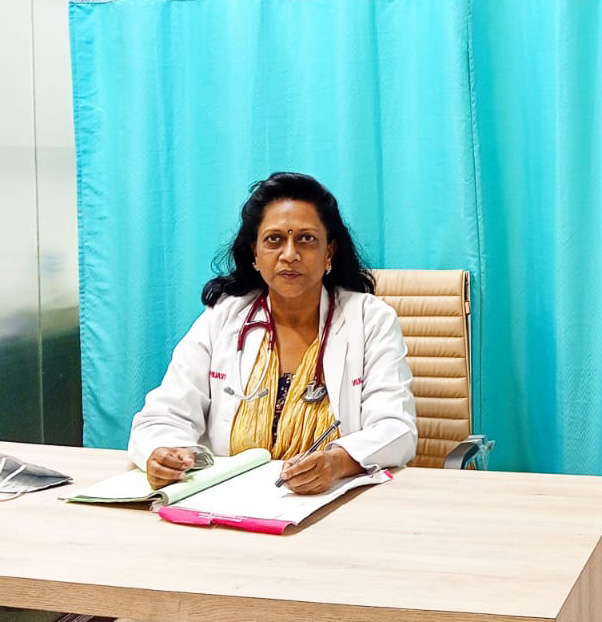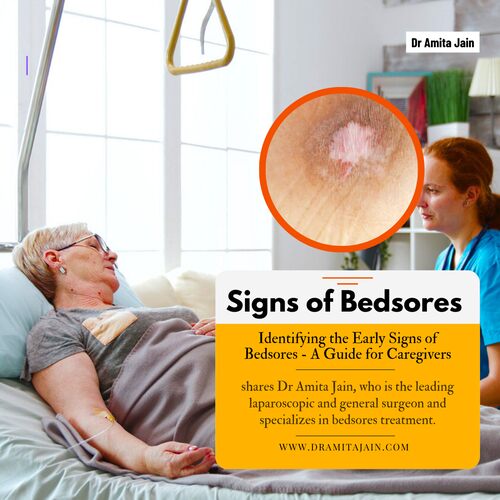Bedsores, also known as pressure ulcers or decubitus ulcers, are injuries to the skin and underlying tissue caused by prolonged pressure on the skin. They often occur in areas where bones are close to the skin, such as the heels, hips, back, and elbows. These sores are common in individuals who are bedridden or in a wheelchair for extended periods. As a caregiver, it’s crucial to understand the early signs of bedsores to prevent further damage and ensure proper care for your loved ones or patients.
How do we identify the early signs of bedsores?
In this article, Dr Amita Jain, the leading surgeon and doctor in Delhi and Gurgaon for bedsores treatment, shares a handy guide for caregivers.
Redness or Discoloration
The first sign of a developing bedsore is often a change in the skin’s color, particularly in areas that experience constant pressure. Healthy skin will typically turn white when pressed, but in the case of early bedsores, the skin may appear red or darker than usual.
This is due to the reduced blood flow to the area, and it can be the first warning sign that pressure is being exerted on the skin for too long. If the redness persists even after relieving pressure, it could indicate the beginning of a bedsore.
Warmth or Tenderness
A common early symptom of bedsores is warmth or tenderness around the affected area. The skin may feel warm to the touch, which is a result of inflammation as the tissue begins to suffer from a lack of proper circulation. If the skin feels unusually warm or sore when gently pressed, it may be an indication that the tissue is becoming compromised, making it more vulnerable to further injury.
Changes in Skin Texture
In the early stages, skin texture may change, becoming firmer or more swollen. The area may feel slightly raised, or the skin may have a spongy or puffy appearance. This is often due to fluid accumulation under the skin, caused by restricted blood flow. If you notice any abnormal texture or swelling, it’s important to take immediate action to relieve the pressure and prevent further deterioration.
Pain or Discomfort
While not always visible, pain or discomfort is a key indicator of developing bedsores. Your loved one may begin to express discomfort when pressure is applied to certain areas or when they are shifted in bed. If they complain of pain in areas where you’ve noticed changes in skin colour or texture, it’s essential to investigate further, as pain is often an early sign of tissue damage.
Blisters or Open Sores
If left untreated, early signs of bedsores can progress to blisters or open wounds. These sores may appear as fluid-filled blisters or broken skin, revealing deeper tissue damage. At this point, the ulceration is more severe, and immediate medical intervention is needed to prevent infection and promote healing.
Prevention and Early Intervention
The best approach to managing bedsores is prevention and early intervention. Regularly repositioning individuals who are bedridden or in a wheelchair can relieve pressure on vulnerable areas. Use cushioning devices like special mattresses, pads, and cushions to reduce pressure. Ensure that the skin is kept clean and dry, and use moisturizing lotions to prevent dryness and cracking.
If you notice any of the early signs mentioned above, it’s essential to act quickly. Reposition the individual, apply pressure-relieving devices, and consult a healthcare professional to assess the situation. Early detection and proper care can make a significant difference in preventing the development of severe bedsores and promoting quicker healing.
By staying vigilant and responsive to the early signs of bedsores, caregivers can protect their loved ones from the pain and complications associated with pressure ulcers.

Dr Amita Jain is a surgeon with the highest degree of professional competence, precision and surgical craftsmanship. Performed all complicated general surgery procedures with in depth knowledge of invasive and few minimal invasive and onco surgical techniques. Underwent special training in trauma, executed various trauma-related complex life-saving neurosurgical procedures, reconstructed injured mangled limbs and performed vascular and reconstructive procedures with critical care.
Dr Amita Jain holds 28 plus years of rich experience in Trauma and General Laparoscopic Surgeries (including Gallbladder stone removal, appendix removal, hernia repair surgery, piles and fissure surgeries). She was the Professor Surgery of at the Army College of Medical Sciences and Base Hospital Delhi Cantt. In 1994 she was commissioned as Surgeon under the United Nations Mission in Congo. From 2020 to 2022, she worked with Bansals Hospital. Currently, Dr Amita Jain is the Senior Consultant, (Speciality: General and Laparoscopic Surgeon) at Artemis Lite Hospital, New Delhi and Sr. General and Laparoscopic Surgeon at Rainbow Children Hospitals, Malviya Nagar, Delhi.
